Switzerland, officially the Swiss Confederation, is a collection of semi-autonomous cantons. As membership of the confederation has fluctuated throughout history, each of these cantons has its own unique history and nobility. Typically, each canton had its own constitution, currency, jurisdiction, habits, customs, history, and nobility.

Rapperswil is a former municipality and since January 2007 part of the municipality of Rapperswil-Jona in the Wahlkreis (constituency) of See-Gaster in the canton of St. Gallen in Switzerland, located between Obersee and the main part of Lake Zurich.

The Rudenz Castle is a fortified tower in Flüelen, a municipality in the canton of Uri in Switzerland.
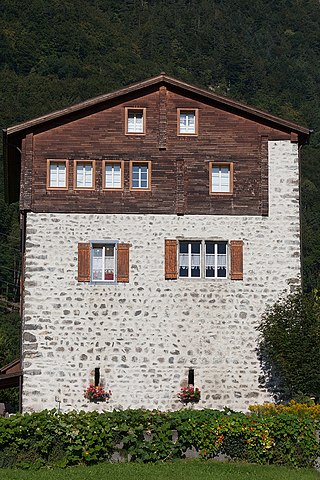
Schweinsberg Castle or Schweinsberghaus is a fortified house in the municipality of Attinghausen in the canton of Uri in Switzerland. It is a Swiss heritage site of national significance.

Greifenstein Castle is a ruined castle in the municipality of Filisur of the Canton of Graubünden in Switzerland. It is included on the register of the Swiss Inventory of Cultural Property of National and Regional Significance.

Fracstein Castle is a castle in the municipality of Seewis im Prättigau of the Canton of Graubünden in Switzerland. It is a Swiss heritage site of national significance.

Sogn Parcazi Castle and Church is a ruined castle and fortified church in the municipality of Trin of the Canton of Graubünden in Switzerland. It is a Swiss heritage site of national significance.

Jegenstorf Castle is a castle in the municipality of Jegenstorf of the Canton of Bern in Switzerland. It is a Swiss heritage site of national significance.
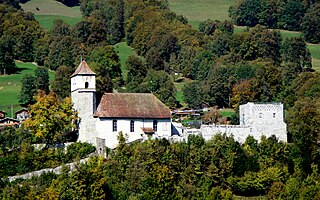
Ringgenberg Castle is a castle in the municipality of Ringgenberg of the Canton of Bern in Switzerland. It is a Swiss heritage site of national significance.

Wartenstein Castle is a castle, now in ruins, located in the municipality of Lauperswil in the Canton of Bern of Switzerland.

The ruins of Grünenberg Castle, Schnabelburg Castle and Langenstein Castle are a complex of three interconnected castles on a hill above the municipality of Melchnau in the canton of Bern in Switzerland. The three castles formed the center of power of the Barons of Grünenberg in the Oberaargau region during the High Middle Ages.
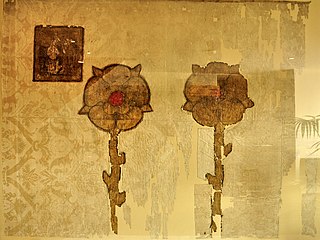
The House of Rapperswil respectively Counts of Rapperswil ruled the upper Zürichsee and Seedamm region around Rapperswil and parts of, as of today, Swiss cantons of St. Gallen, Glarus, Zürich and Graubünden when their influence was most extensive around the 1200s until the 1290s. They acted also as Vogt of the most influential Einsiedeln Abbey in the 12th and 13th century, and at least three abbots of Einsiedeln were members of Rapperswil family.

The Ruins of Radegg are the ruins of a spur castle built around the year 1200 in the Canton of Schaffhausen, Switzerland and destroyed around the year 1300. It is located high above the Wangental on a spur of the Rossberg which drops off steeply on three sides in Osterfingen in the municipality of Wilchingen.

Alt-Regensberg Castle is a hill castle which was built about the mid-11th century AD by the House of Regensberg in the Swiss municipality of Regensdorf in the Canton of Zürich.

The noble family von Sax or Saxe was a medieval noble family in eastern Switzerland. They owned estates and castles on both sides of the Alps in the modern cantons of St. Gallen, Graubünden and Ticino. The origin of the family is unknown, but they probably stem from Churrätien nobility and were related to the da Torre family. The family divided into two main lines; the Grafen (counts) von Sax-Misox and the Freiherren (barons) von Hohensax.

Rudenz Castle is a ruined castle atop a hill in the municipality of Giswil in the canton of Obwalden in Switzerland. The castle and surroundings are a Swiss heritage site of national significance.
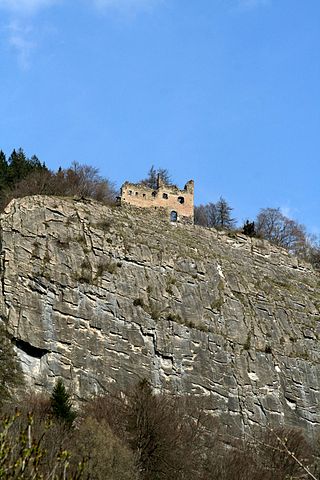
Lichtenstein Castle is a ruined castle in the municipality of Haldenstein of the Canton of Graubünden in Switzerland.

Wynegg Castle is a ruined castle in the municipality of Malans of the Canton of Graubünden in Switzerland.
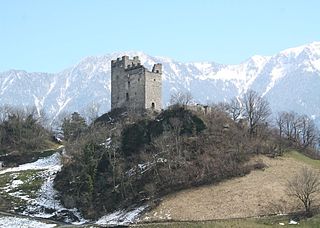
Wartau Castle is a ruined castle in the municipality of Wartau of the Canton of St. Gallen in Switzerland. It is a Swiss heritage site of national significance.




















